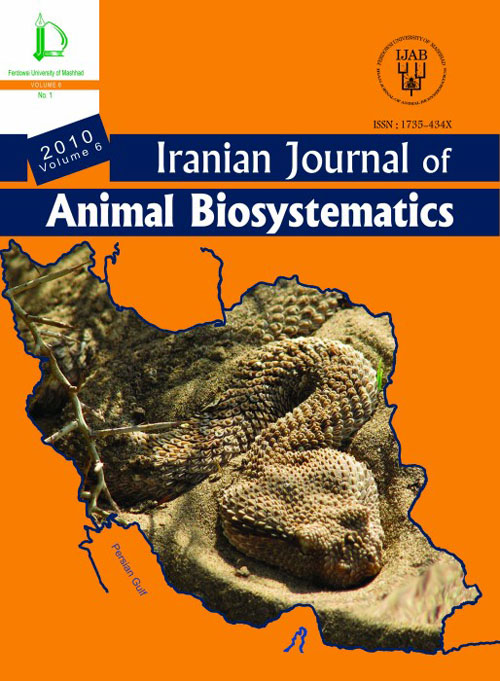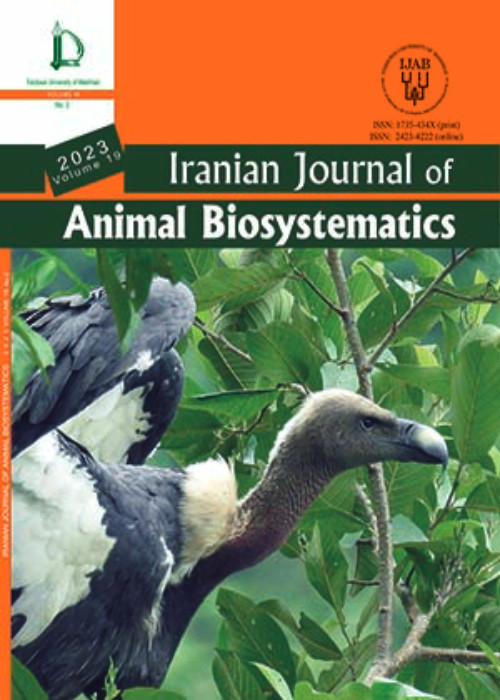فهرست مطالب

Iranian journal of animal biosystematics
Volume:10 Issue: 2, Summer-Autumn 2014
- تاریخ انتشار: 1393/09/19
- تعداد عناوین: 11
-
-
Pages 81-85Ptinidae or spider beetles, is a worldwide family of beetles especially distributed in the subtropical and temperate zones including Iran. Niptus holoeucus (golden spider beetle) from Kangohar cave in Fars Province (Iran) is described as new record for Iran. We regarded this beetle as a troglophile and guanophile species.Keywords: Iran; Ptinidae; Niptus holoeucus; Kangohar Cave
-
Pages 87-100Two species of the family Colubridae were compared based on cranial osteology. The specimens were from Kermanshah province (2010–2012). We compared the skulls of the two species and distinguished their differences. According to our study, eight elements of the skull are clearly different between the two species. These differences are speculated to relate to different diets, prey size or concluded from an evolutionary processes to adapt especial conditions or competition with other sympatric species. Differences and characteristics of the above species help to facilitate their identification and evaluate phylogenetic studies in relation to skull morphology.Keywords: Colubridae, Eirenis collaris, Dolichophis jugularis, comparative cranial osteology
-
Pages 101-117A total of 23 species and 19 genera were identified. The genus Coecobrya Yosii 1956 (Entomobryidae) is recorded for the first time from Iran. Family Paronellidae and three species Cyphoderus albinus Nicolet 1842 (Paronellidae), Sinella curviseta Brook 1882 and Entomobrya lindbergi Stach 1960 (Entomobryidae) are reported for the first time from Mazandaran province. Also an identification key for families and genera which have found until now from this province, is presented.Keywords: Entomobryomorpha, identification key, Iran
-
Pages 119-136The northwest Iran comprises parts of two major biodiversity hotspots; Irano-Anatoli and Caucasus. It is a mountainous transition realm between Caucasus forest in the north, Pontic forest of Turkey in the west and central deserts of Iranian Plateau. This study was designed to determine rodent diversity in northwest Iran. Moreover, corridor and barrier features of the region were investigated, as well. The samplings were done in different localities of northwestern Iran. In addition, all specimens of the Zoology Museum of Ferdowsi University of Mashhad (ZMFUM) attributed to the region were denoted. The study shows that the specimens belong to 18 nominal forms attributing to 5 families: Muridae (Apodemus witherbyi, Mus musculus domesticus, Mus macedonicus, Meriones persicus rossicus, M. libycus erythrourus, M. vinogradovi and M. tristrami bogdanovi), Gliridae (Dryomys nitedula pictus), Cricetidae (Microtus socialis, M. obscurus, M. qazvinensis, Chionomys nivalis trialeticus, Arvicola amphibious persicus, Ellobius lutescens lutescens, Cricetulus migratorius pulcher and Mesocricetus brandti brandti), Dipodidae (Allactaga williamsi schmidti) and Calomyscidae (Calomyscus urartensis).Keywords: Fauna, Muridae, Cricetidae, Calomyscidae, Gliridae
-
Pages 137-144154 specimens of Periophthalmus waltoni distributed in seven different sites in the Persian Gulf and Gulf of Oman are analysed, utilizing ten morphometric characters. Canonical Variate Analysis (CVA) of the sampling sites suggested a partial separation between the north-western sites and the central plus south-eastern sites. The main factor to connect P. waltoni specimens from different sites and keep them similar, morphologically and probably genetically, could be moving their larvae. It could be deduced that environmental factors are the main reason to discriminate between P. waltoni specimens from different stations.Keywords: Gulf of Oman, morphometric variables, mudskippers, Persian Gulf
-
Pages 145-160In order to study the fauna of ichneumonid wasps (Hym., Ichneumonidae), a survey was carried out during 2010-2013 in various localities in Khorasan Razavi province. Samples were collected using sweeping net by irregular patterns on the common field crops and in the orchards. 234 specimens, in total were collected and identified. They were consisting 26 species belong 25 genera of 12 subfamilies. Among them, 16 species are new for Khorasan fauna including Anomalon cruentatum (Geoffroy, 1785) and Barylypa propugnator (Geoffroy, 1785) (Anomaloninae); Exetastes syriacus Schmiedeknecht, 1910 and Lissonota pleuralis (Brischke, 1880) (Banchinae); Diadegma semiclausum (Hellén, 1949) and Sinophorus xanthostomus (Gravenhorst, 1829) (Campopleginae); Dichrogaster longicaudata (Thomson, 1884), Dichrogaster saharator (Aubert, 1964) and Trychosis legator (Thunberg, 1822) (Cryptinae); Enizemum ornatum (Gravenhorst, 1829), Homotropus signatus (Gravenhorst, 1829) and Promethes sulcator (Gravenhorst, 1829) (Diplazontinae); Diadromus collaris (Gravenhorst, 1829), Dicaelotus pumilus (Gravenhorst, 1829) and Ichneumon proletarius Wesmael, 1848 (Ichneumoninae); Orthocentrus strigatus Holmgren, 1858 (Orthocentrinae). Three species including Exetastes syriacus, Lissonota pleuralis and Dicaelotus pumilus are new records for the fauna of Iran.Keywords: Alfalfa, Dicaelotus pumilus, Exetastes syriacus, fauna, Lissonota pleuralis
-
Pages 161-174The Thysanoptera fauna of Iran are still very incompletely known. As a result of the study of thrips fauna in different localities of Khorasan-e-Razavi province during 2012-2014, a total of 46 species in 20 genera and 3 families are recorded for this area. Among them, 43 species are newly recorded for the fauna of this province; and Pezothrips dianti is newly recorded for the fauna of Iran. Distribution in Iran, in the world and some taxonomic notes are given for some species.Keywords: Thrips, Thysanoptera fauna, new record, Khorasan, e, Razavi, Iran
-
Pages 175-184So far, four species of Hemidactylus have been reported in Iran as follows: H. persicus, H. robustus, H. flaviviridis, H. romeshkanicus. In this study, 108 specimens belonging to these four species of Hemidactylus were examined morphologically, using 19 metric and 6 meristic characters. Multivariate analyses showed morphological differences among these three species with exception H. romeshkanicus which was found to be indistinguishable from the specimens of H. persicus, especially in the DFA analysis. In spite of, grouping the holotype of H. romeshkanicus with population of H. persicus especially in DFA analyses and presences of high intraspecific variation among populations of H. persicus complex, we could not definitely decide about the taxonomic status of H. romeshkanicus with only one specimen. But we suggest that latter species probably belongs to a local populations inside H. persicus complex.Keywords: Gekkonidae, Hemidactylus, Morphometric analysis, Iranian plateau, metric characters, meristic characters
-
Pages 185-194The Spotted Toad-headed Agama, Phrynocephalus maculatus, is a member of the Agamidae family distributed in the central and south-eastern deserts of Iran. Iranian specimens are rare in collections. In this research, the female reproductive cycle of this species was studied from April 5 to August 5, 2013. Totally, 15 adult females were collected by hand at midday from southern parts of Damghan County, located in Semnan Province of Iran. Ovaries were removed and processed for histological and morphometric studies. The oogenic cycle begins from early April, mating occurs at the beginning of May, with oviposition occurring from late May to mid July. Females lay 2-3 eggs per clutch with the possibility of producing a secondary clutch later in the season. Maximum reproductive activity occurs in May and early June and reduces from early July and ends in August. There was no significant difference between the right and left side of the reproductive system. Hence, oogenesis occurs from April through July, Ph. maculatus follows an associated reproductive cycle typical for temperate species.Keywords: Lizard, Agama, Phrynocephalus maculatus maculatus, oogenesis, reproduction
-
Pages 195-203During 2012-2013 in a funistic survey of Snails, several species of snails were collected and identified; both from orchards, farms and the weeds. In total, 18 species belonging to 17 genera out of 10 families are identified based on morphometric characteristics including (shape and size of operculum, aperture, dextral or sinistral of shell, pneumostome, keel, radula, renal ridge and reproduction system). As a result, Vitrea contortula, Vallonia tenuilabris and Orculella sirianocoriensis identified as new record for Iranian mollusc fauna. Besides, the most damaging species within the yielded list identified as Helicella krynickii that has much importance within the north west of region.Keywords: snails, Identification, Fauna, orchards, farms, Weeds, West Azarbaijan province, Iran
-
Pages 205-208Odonata fauna is poorly known in Iran and most of the previous studies deal with northern parts of the country, studying adult specimens. We sampled Karun River for aquatic insects in the city of Ahvaz in south-west of Iran during 2009–2011. As a result, 40 nymphs of one damselfly species and four dragonfly species of the order Odonata comprising five genera from four families were recorded. All of the species is newly reported from Khuzestan province. Species list with their distribution data in Iran and the material examined are presented.Keywords: Odonata, Zygoptera, Anisoptera, faunistics, Khuzestan province


